Centauri Dreams
Imagining and Planning Interstellar Exploration
Exoplanets: The Interplanetary Dust Factor
I usually get up while it’s still dark and take a walk. The idea is to shake the night’s dreams out of my head, listen to the birds waking up and pull in a lot of fresh air, all conducive to thinking about what I want to write that day. Last fall I kept noticing the glow before morning twilight that marked the zodiacal cloud, faint enough to be lost in moonlight and challenging to see when competing with city lights. But catch the right conditions and its diffuse glow is apparent, as in the photograph below, a striking example of zodiacal light’s effect.

Image: Sometimes mistaken for light pollution, zodiacal light is sunlight that is reflected by zodiacal dust. It is most visible several hours after sunset on dark, cloudless nights surrounding the spring and fall equinoxes, when the Earth’s equator is aligned with the plane of the solar system. Credit: Malcol.
What we’re seeing, especially at times when the ecliptic is at its largest angle to the horizon, hence autumn and spring, is the light of the Sun reflecting off dust in the Solar System. Most of the material in this interplanetary dust cloud is concentrated along the plane of the system, and as you would expect, similar dust clouds are to be found around other stars. The Spitzer Space Telescope, for instance, has found evidence for a strong dust cloud around the star HD 69830, presumably the result of collisions within the system. No planet has yet been found there.
We often talk about interstellar gas and dust as serious issues for spacecraft moving at a substantial percentage of the speed of light. But what about interplanetary dust? The complications it poses involve how we see exoplanets, particularly those in the habitable zone.
Imagine zodiacal light perhaps a thousand times brighter than our own, enough to outshine the Milky Way. The challenge such light presents to astronomers are potentially serious but not well quantified, which is one reason why researchers using the Large Binocular Telescope Interferometer (LBTI) on Arizona’s Mt. Graham has been at work in a program called HOSTS — the Hunt for Observable Signatures of Terrestrial Systems. The team’s paper in the Astrophysical Journal gives us a look at the survey’s early results.
“There is dust in our own solar system,” says Philip Hinz, the lead for the HOSTS Survey team and associate professor of astronomy at the University of Arizona. “We want to characterize stars that are similar to our own solar system, because that’s our best guess as to what other planetary systems might have life.”

Image: This artist’s concept illustrates what the night sky might look like from a hypothetical alien planet in a star system with an asteroid belt 25 times as massive as the one in our own solar system (alien system above, ours below. Credit: NASA/JPL-Caltech.
Steve Ertel (University of Arizona) is lead author of the paper, which delves into the question of how much dust within a stellar system can affect our ability to see planets within it. All of this goes into planning for future space telescopes, with the HOSTS survey examining the issue for 30 nearby stars. What we learn from the paper is that exozodiacal dust in the stars surveyed is typically less than 15 times the amount found in our own Solar System’s habitable zone.
But planets with larger dust volumes become seriously problematic. Epsilon Eridani, long of interest because of its proximity to the Sun (10.5 light years) is one of these. Says Ertel:
“It is very nearby. It’s a star very similar to our sun. It would be a very nice target to look at, but we figured out that it would not be a good idea. You would not be able to see an Earth-like planet around it.”
Even so, Epsilon Eridani offers us a useful study in planet formation, albeit one with serious challenges for observers. This is from the paper, referring to a previously studied dust clump in the system, which could indicate:
…local dust production in the known asteroid belt and potential shepherding by a planet interior to the belt which could also be creating the clump. There is a long history of planet claims for ?Eri, but radial velocity detection is complicated by stellar activity induced jitter. The existence of the planet claimed by Hatzes et al. (2000) and Benedict et al. (2006) has been debated in the literature (Anglada-Escudé & Butler 2012; Howard & Fulton 2016), it is possible that a planet of period 6.8 – 7.3 yr and mass 0.6 – 1.55 MJup does orbit the star. Attempts to infer the presence of outer planets based on the ring structure are problematic due to the uncertain nature of the intrinsic disk morphology.
This is interesting stuff, although as the paper is at pains to note, we are very early in the study of dust distribution at this level. The issue can tell us something about the possibility of planets within a star system. Given the standard model — that dust is formed during asteroid collisions and spirals inward so that it is distributed throughout the entire system — the survey turned up at least one surprising result. We’ve known for some time that the star Vega has a large belt of cold dust in about the same relation to Vega as the Kuiper Belt is to our system. There is also a disk of hot dust very close to the star. From the paper:
A most puzzling result is our non-detection of warm dust around Vega, for which massive asteroid belt and Kuiper belt analogs have been detected in the mIR to fIR and a large amount of hot dust has been detected in the nIR. This raises the question of what mechanism clears the region between ?0.5 AU and ?5 AU from the star of dust.
We have as yet to detect planets around Vega, but the lack of habitable zone dust may be telling us about a massive planet whose gravitational influence could be clearing this area or, as Ertel notes, several Earth-mass planets. Several other stars in the survey showed, unlike Vega, no dust belts close to the star or far from it, but large amounts of warm dust in the habitable zone. A massive asteroid belt producing numerous collisions could be the culprit in such cases.
Overall, the HOSTS survey to this point has been able to make four new detections of habitable zone dust among its 30 stars; among these, three are the first to be found around Sun-like stars, and two occur around stars without any previous detections of circumstellar dust. The paper notes that the survey’s sensitivity is five to ten times better than previous results. Future exo-imaging attempts will be well served by extending the survey to a larger sample of stars, so we’ll know how the quantity of dust in a given system affects our ability to see HZ planets.
The paper is Ertel et al., “The HOSTS survey – Exozodiacal dust measurements for 30 stars,” Astrophysical Journal Vol. 155, No. 5 (17 April 2018). Abstract / preprint.

Gaia: Data Release 2 Announced
Back in the late 1970s I didn’t know anything about star catalogs. I suppose that, if asked, I would have assumed they were out there — how otherwise could astronomers do their jobs? But the first catalog of stars that came into my life emerged when I was writing an article about SETI, a field I developed an intense interest in and at that time knew very little about. For the article I needed to identify the closest stars, and thus I stumbled upon the Gliese Catalog of Nearby Stars, and over the course of time became absorbed by the idea of exoplanets.
In many ways my first dip into the Gliese catalog began the journey that continues here, because that first SETI article was the forerunner of the kind of writing I have been doing since the turn of the century. In that time our catalogs have grown more and more interesting to me, but none can match today’s, the all-sky view of almost 1.7 billion stars that is the result of the European Space Agency’s Gaia mission. The second Gaia data release became available on April 25 and includes parallax, proper motion and color data for more than 1.3 billion of these stars.
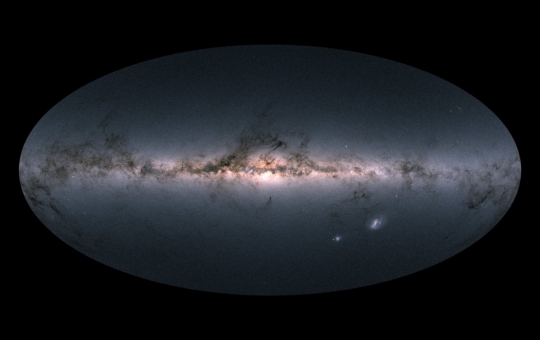
Image: Gaia’s all-sky view of our Milky Way Galaxy and neighbouring galaxies, based on measurements of nearly 1.7 billion stars. The map shows the total brightness and colour of stars observed by the ESA satellite in each portion of the sky between July 2014 and May 2016. Brighter regions indicate denser concentrations of especially bright stars, while darker regions correspond to patches of the sky where fewer bright stars are observed. The colour representation is obtained by combining the total amount of light with the amount of blue and red light recorded by Gaia in each patch of the sky. The bright horizontal structure that dominates the image is the Galactic plane, the flattened disc that hosts most of the stars in our home Galaxy. In the middle of the image, the Galactic centre appears vivid and teeming with stars. Credit: ESA.
You might note the two bright objects at lower right. These are the Large and Small Magellanic clouds, two of the dwarf galaxies that orbit the Milky Way. Note as well the darker regions along the galactic plane, clouds of interstellar dust that hide the light of stars behind and within them, some serving as the breeding ground for young stars.
This is the richest star catalog yet produced, based on 22 months of observation. Gaia, says ESA director of science Günther Hasinger, is “redefining the foundations of astronomy.” And he adds:
“Gaia is an ambitious mission that relies on a huge human collaboration to make sense of a large volume of highly complex data. It demonstrates the need for long-term projects to guarantee progress in space science and technology and to implement even more daring scientific missions of the coming decades.”
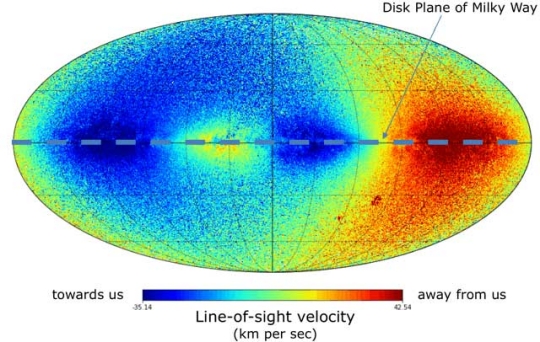
Image: The all-sky map of median velocities of stars towards or away from the Sun. The large scale pattern caused by rotation of our Galaxy is evident. Credit: DPAC/ESA.
We’ve had quite a jump here, moving from the first data release, published in 2016, and containing the distances and motions of 2 million stars, to today’s 1.7 billion. ESA is saying that the new release identifies the positions of some of the brightest stars in the field to the same level of precision as Earth observers would need to spot a coin on the surface of the Moon. We achieve estimated distances to individual stars for about ten percent of the total catalog.
A news release from the Science & Technology Facilities Council (UK) surveys what’s available:
This second data release allows progress in all these studies by providing not only distances and apparent motions across the sky for 1.3 billion sources, but also very precise measurements of brightness and colour for an even larger catalogue of 1.7 billion sources. Seven million stars have their line of sight velocities measured, providing full 6-dimensional – three space positions, 3 space motions – information, determining full orbits for those stars in the Milky Way. This is the information needed to weigh the Galaxy, and determine the distribution – and perhaps the properties – of Dark Matter, the mysterious substance which dominates the mass of the Galaxy and the Universe. Credit: Science & Technology Facilities Council’s (STFC) Rutherford Appleton Laboratory, UK.
Out of Gaia comes a refined version of the Hertzsprung-Russell diagram, an essential tool relating stellar intrinsic brightness to color that helps us make sense of the evolution of stars. Gaia offers data on four million stars within 5,000 light years of the Sun, revealing fine-grained details in the traditional H-R plot, including differing signatures for white dwarfs with hydrogen-rich and helium-rich cores, and the ability to distinguish between disk and halo stars. The orbits of 75 globular clusters and 12 dwarf galaxies around the Milky Way can likewise be derived.
“The new Gaia data are so powerful that exciting results are just jumping at us,” says Antonella Vallenari from the Istituto Nazionale di Astrofisica (INAF) and the Astronomical Observatory of Padua, Italy, deputy chair of the data processing consortium executive board. [W]e have built the most detailed Hertzsprung-Russell diagram of stars ever made on the full sky and we can already spot some interesting trends. It feels like we are inaugurating a new era of Galactic archaeology.”
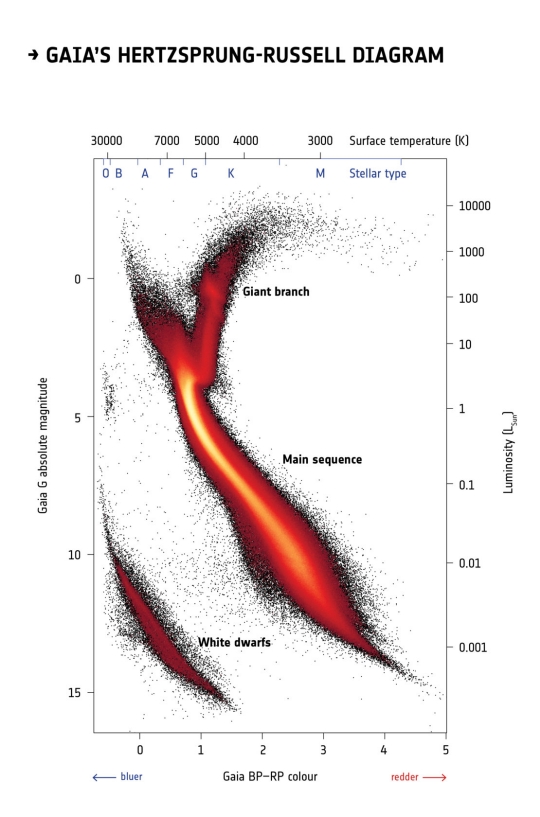
Image: Named after the two astronomers who devised it in the early twentieth century, the Hertzsprung-Russell diagram compares the intrinsic brightness of stars with their colour and is a fundamental tool to study populations of stars and their evolution. Credit: ESA.
Papers on the second Gaia data release appear in a special issue of Astronomy & Astrophysics, while numerous video and virtual reality resources are available here. As we look forward to abundant discoveries from the current release, it’s worth remembering that the final Gaia catalog will not be published until the 2020s. The five-year Gaia mission has been approved for extension until the end of 2020. Gaia’s 3-dimensional map of our galaxy shows 600 times more stars than previously available and covers a volume 1,000 times larger than the first Gaia data release, with a precision 100 times larger. It is hard to imagine any area of astrophysical research that will not be advanced by the availability of these data.
And I have to add this coda: Star catalogs, after all these years, still astound me. I think that’s because the sheer scale of things is so astonishing. After all, the massive Gaia haul at this point reaches 1.7 billion stars, out of a galaxy made up of perhaps 200 billion, in a universe of galaxies whose true extent we are still trying to fathom. Our cataloging species has only begun its immense task.

More News from the ‘Planet of Doubt’
The detection of hydrogen sulfide just above the upper cloud deck of Uranus has received the nods you might expect to rotten eggs, H2S having the odor of such unappetizing objects. But this corrosive, flammable gas is quite an interesting find even if it makes a whiff of Uranian air more off-putting than it already was. Not that you’d live long enough to notice the scent if you happened to be there, as Patrick Irwin (University of Oxford, UK) is quick to note:
“If an unfortunate human were ever to descend through Uranus’s clouds, they would be met with very unpleasant and odiferous conditions. Suffocation and exposure in the negative 200 degrees Celsius atmosphere made of mostly hydrogen, helium, and methane would take its toll long before the smell.”
We can leave that excruciating end to the imagination of science fiction writers, among whom I want to mention my two favorite stories about this planet, Geoff Landis’ “Into the Blue Abyss” (2001) and Gerald Nordley’s “Into the Miranda Rift” (1993). And I always give Stanley Weinbaum full credit for the best Uranus story title of all time: “The Planet of Doubt” (1935).
Patrick Irwin is lead author on the paper discussing the H2S discovery, which is a significant one because it highlights the differences between the cloud decks on the two closer gas giants — Jupiter and Saturn — and the outer ice giants Uranus and Neptune. The former show no trace of hydrogen sulfide above the clouds, while ammonia is clearly present. In fact, most of Jupiter and Saturn’s upper clouds are laden with ammonia ice, a difference that can tell us much about the formation of the respective planets and their subsequent development.
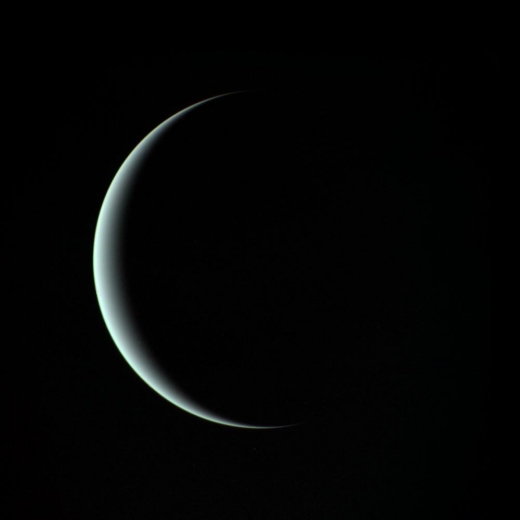
Image: This image of a crescent Uranus, taken by Voyager 2 on January 24th, 1986, reveals its icy blue atmosphere. Despite Voyager 2’s close flyby, the composition of the atmosphere remained a mystery until now. Credit: NASA/JPL-Caltech.
Leigh Fletcher, a member of the research team from the University of Leicester in the UK, notes that the balance between nitrogen and sulfur, and thus between ammonia and hydrogen sulfide, would have depended on the temperature and the location of the planet when it formed. These differences, in other words, are the signature of the gas giants’ formation history, adding to the evidence that the giant planets migrated from the position of their original formation.
Fletcher adds that when a cloud deck forms by condensation, most of the gas forming the cloud becomes embedded in a deep internal reservoir, putting it out of the view of our telescopes:
“Only a tiny amount remains above the clouds as a saturated vapour,” said Fletcher. “And this is why it is so challenging to capture the signatures of ammonia and hydrogen sulfide above cloud decks of Uranus. The superior capabilities of Gemini finally gave us that lucky break.”
Indeed. It took the 8-meter Gemini North telescope at Mauna Kea (Hawaii) to make the find, which the researchers achieved through spectroscopic analysis using the Near-Infrared Integral Field Spectrometer (NIFS), which sampled reflected light from a region just above the main visible cloud layer in the atmosphere of Uranus. Irwin describes these lines as being “just barely there,” at the outer limits of detection, but finding them in the Gemini data has solved a mystery of this planet’s atmospheric composition that persisted even through the Voyager flyby.

Image: Hydrogen sulfide is hardly the only interesting thing about Uranus. Near-infrared views of the planet reveal its otherwise faint ring system, highlighting the extent to which it is tilted. Credit: Lawrence Sromovsky (University of Wisconsin – Madison) / Keck Observatory.
Thus we finally identify a component of the Uranian clouds that it probably shares with Neptune, and the ‘planet of doubt’ takes us a little closer to revealing the secrets of the ice giants. The paper is Irwin et al., “Detection of hydrogen sulfide above the clouds in Uranus’s atmosphere,” published online by Nature Astronomy 23 April 2018 (abstract).

NEOWISE: New Data Release, Implications
The Wide-field Infrared Survey Explorer (WISE) has been featured often in these pages, usually in terms of brown dwarfs and the possibility of uncovering a small star or brown dwarf closer than Proxima Centauri. But while we still have no evidence of such, we do have abundant data on brown dwarfs, as well as a useful compendium of objects that come close to the Earth.
For WISE, launched in 2009 and placed into hibernation in 2011 upon completion of its primary mission, was reactivated in 2013 as NEOWISE. The goal is now the observation of asteroids and comets both near and far by way of characterizing their size and composition.
Amy Mainzer (JPL), NEOWISE principal investigator, points to the mission’s success:
“NEOWISE continues to expand our catalog and knowledge of these elusive and important objects. In total, NEOWISE has now characterized sizes and reflectivities of over 1,300 near-Earth objects since the spacecraft was launched, offering an invaluable resource for understanding the physical properties of this population, and studying what they are made of and where they have come from.”
The WISE/NEOWISE archive is publicly available through IRSA, the NASA/IPAC Infrared Science Archive. The animation below shows detections during NEOWISE’s four years of operation under the current mission parameters. All told, 2.5 million infrared images were collected during the fourth year and are now combined with the prior three years of NEOWISE data in the archive. 10.3 million sets of images are available, and a database of more than 76 billion source detections extracted from those images. The April, 2018 NEOWISE data release can be found here.
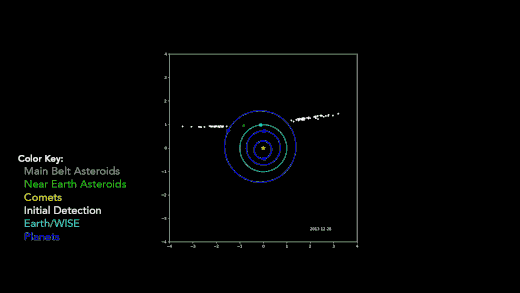
Image: This movie shows the progression of NASA’s Near-Earth Object Wide-field Survey Explorer (NEOWISE) investigation for the mission’s first four years following its restart in December 2013. Green dots represent near-Earth objects. Gray dots represent all other asteroids which are mainly in the main asteroid belt between Mars and Jupiter. Yellow squares represent comets. Credit: NASA/JPL-Caltech/PSI.
Obtaining measurements of the diameters and albedo of near-Earth objects through infrared observation, NEOWISE has, in its four years of tracking asteroids and comets, scanned the skies a total of eight times, observing 29,375 objects, a total that includes 788 near-Earth objects and 136 comets since the WISE to NEOWISE transition. Ten of these objects have been classified as PHAs, or potentially hazardous asteroids, based on both their size and the proximity of their approach to Earth’s orbit. In fact, the first PHA found by WISE was 2013 YP139, discovered a mere six days after observations resumed in December, 2013.
We’re now well into the ninth sky coverage period for NEOWISE, with the mission extended through June of 2018. Although potentially hazardous asteroids obviously get greater attention, not all of the mission’s news has been made among this population. In mid-2017, for example, we learned that mission scientists had found about seven times more long-period comets measuring at least one kilometer across than had previously been predicted. Long-period comets take more than 200 years to complete a single revolution of the Sun.
That was a finding with interesting implications:
“The number of comets speaks to the amount of material left over from the solar system’s formation,” said James Bauer, lead author of the study and now a research professor at the University of Maryland, College Park. “We now know that there are more relatively large chunks of ancient material coming from the Oort Cloud than we thought.”
Although discovered in the NEOWISE era, the paper on this work actually draws on data produced during the original WISE mission, an example of how the spacecraft continues to let us examine objects both near and far, including those that have been perturbed out of their orbits in the Oort Cloud, pristine material from the Solar System’s era of formation. That there are so many more long-period comets than predicted would seem to reinforce the idea that cometary delivery of icy materials from the outer Solar System must have been common.
The paper on the long-period cometary population is Bauer et al., “Debiasing the NEOWISE Cryogenic Mission Comet Populations,” Astronomical Journal Vol. 154, No. 2 (July 2017). Abstract available.

Holographic Sails for Project Starshot? — Homage to Bob Forward
One of the reasons I described Greg Matloff as the ‘renaissance man of interstellar studies’ in my Centauri Dreams book is the continuing stream of ingenious ideas that he develops and delivers through papers and conference presentations. I found the holographic sail concept below fascinating, and would have referenced Bob Forward myself if Greg hadn’t already done it in the text. These two must have been great to hear in conversation! Read on to learn how Greg, a physicist at New York City College of Technology (CUNY) came up with the idea, a process that deftly blended science and art and may provide solutions to some of the more intractable problems posed by Breakthrough Starshot. The author of The Starflight Handbook among many other books (volumes whose pages have often been graced by the artwork of the gifted C Bangs), Greg has been inspiring this writer since 1989.
By Greg Matloff
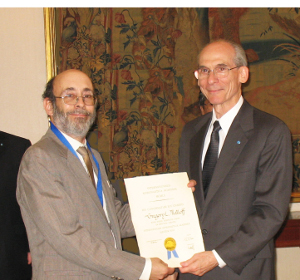
It was perhaps inevitable that I would be asked to serve on the Advisor’s Board of Yuri Milner’s Breakthrough Starshot, because of my long experience in the analysis of interstellar travel techniques. According to Phil Lubin’s paper on this technology development project, a 50-70 GW laser array mounted atop a southern hemisphere mountain would generate a beam that would be projected against an Earth orbiting ~1 m photon sail for a period of minutes [1]. The sail would be a major component of a ~1 gram wafer-scale spacecraft with a ~0.1-gram payload that would exit the beam after experiencing average accelerations of ~5,000 g. The planned interstellar cruise velocity of the tiny spacecraft is ~0.2c and the voyage time to the Proxima/Alpha Centauri system is approximately two decades.
Image: Gregory Matloff (left) being inducted into the International Academy of Astronautics by JPL’s Ed Stone.
So I attended the first Starshot Advisors Meeting in August 2016 and left with a non-optimistic attitude. Yes, it is possible to design very-high efficiency optical reflectors at the laser wavelength (about 1 micron) to tolerate the enormous thermal load while maximizing acceleration [1]. But these devices tend to be physically thick and massive.
A major problem turned out to be beam-riding sail stability. The sail must be configured to remain in the beam, with its source located on the moving Earth and its terminus directed towards the Centauri system, for a period of minutes. Analysis discussed during the August 2016 meeting and later published revealed that a spherical sail curvature was the best approach to address the beam-riding stability issue [2]. But how would the sail maintain its required spherical curvature during the minutes-duration high-acceleration run?
Finally, rare ~1-micron interstellar dust grains impacting a sail moving through the interstellar medium at ~0.2c pack quite a wallop [3]. So if the spherical sail somehow survived acceleration, it would be a good idea to straighten it post-acceleration to a flat sheet and reorient the spacecraft edge-on to the direction of travel.
Initially, I could think of no way to satisfy all of these requirements. So I encouraged theoretical physicists associated with CUNY to think about ways of increasing graphene reflectivity in response to an expected Request for Proposals (RFP) from the Starshot management team. Because such a development is not impossible, I delivered several papers on the utility of reflective graphene in interstellar solar-photon sailing. In collaboration with other researchers, I also considered toned-down space applications of wafer-scale spacecraft and less intense collimated power beams. Even if the Starshot goal could not be met, I hoped that some major technological advances might come from the decade-duration, $100 million research effort.
But the goals of robotically exploring the planetary systems of our nearest stellar neighbors on voyages requiring a few decades seemed too enticing to simply abandon. So when my partner, artist C Bangs, suggested that I reconsider holographic photon sail coatings, a concept we had collaborated on in 2000-2001, I agreed.
Bob Forward and Holographic Photon Sails
Long before C and I married, we were collaborators. She has generated chapter frontispiece art for most of my books, including The Starflight Handbook. During the summer of 2000, my second year as a NASA Faculty Fellow at Marshall Spaceflight Center in Huntsville Alabama, we attended an International Academy of Astronautics symposium organized by Giancarlo Genta of Politechnico di Torino in Aosta, an Italian alpine city. My participation was concerned with extrasolar and interstellar solar-photon sailing, since NASA had funded my research in the Heliopause Sail Technology Project, under the direction of Les Johnson. C’s role was to curate and hang an art show, “Messages from Earth”, in a medieval Aosta chapel. About 30 international artists contributed work presenting their conceptual message plaques that could be mounted on a solar-photon sail bound for the stars.
During the reception associated with the art show, C was approached by the late Robert Forward. As many Centauri-Dreams readers will remember, Bob pioneered numerous approaches to interstellar travel during the last few decades of the twentieth century. When Bob reached into his wallet and withdrew a credit card, on-lookers expected that he might be making a purchase. Instead, he asked C how she would affix a message plaque to the sail. She responded that a physical plaque (as was done in Pioneer 10/11), a long-playing phonographic record (as was done in Voyager 1/2) or a computer chip were possible approaches. Bob drew her attention to the white-light hologram on the credit card and expressed the opinion that a low-mass, thin-film holographic plaque could contain a huge amount of information.
After the symposium, C returned to Brooklyn and I rejoined the Marshall sail team. A few weeks later, while C was coincidentally visiting me in Huntsville, we were invited to a lecture by Bob. When Les Johnson introduced him, Bob pointed to C and said: “Fund that woman to do a prototype holographic interstellar message plaque”.
So my small NASA University Challenge Grant through Pace University, where I taught at the time, was reconfigured to support the creation of the hologram. I received no salary from this grant so that the project could be financed. We contacted the Center for Holographic Arts (then located in Long Island City) and the rainbow hologram was completed at that facility with two sculpted figures and four line drawings by C with a transparency of the Apollo 17 image of Earth from deep space that is always visible and supports the holographic images.
We delivered one of the three resulting holograms to NASA Marshall in mid-2001. Another was later purchased by a collector and donated to New York City College of Technology. We use the third for display purposes.
There are seven 2D and 3D monochromatic images on this hologram, representing our solar system, probe trajectory and the human form in a similar manner to the Pioneer plaque. During the summer of 2001, we showed it to many NASA and contractor employees. As part of the research effort associated with the plaque, we participated in simulated space-radiation tests of holographic wrapping paper samples. Holograms are apparently immune to image degradation caused by intense solar flares [4-6].
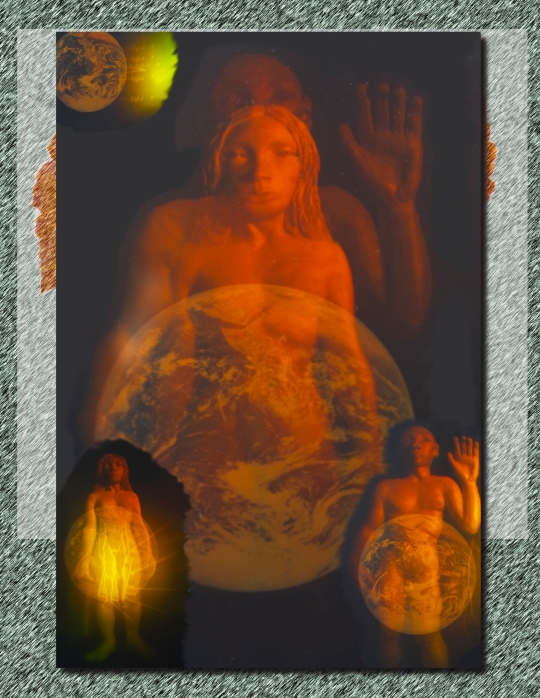
Image: A view of the Rainbow Hologram created by C Bangs. The hologram contains six images. As the viewer moves from left to right the images transition from one frame to the next. On the extreme left side is a line drawing that places our home solar system on the edge of the Milky Way Galaxy and our planet, third from our sun. The second frame is a line drawing of the female figure holding the payload of the solar sail to demonstrate her size relative to it. The third frame is the sculpted female figure. The fourth frame is the sculpted male figure with his hand raised in what is believed to be a universal greeting. The fifth frame is a line drawing of the male figure. The last frame contains equations that describe the acceleration of the solar sail that the hologram would hypothetically be traveling on. In front of all the images is an photograph of the full Earth visually demonstrating the beauty of our home planet. Credit: C Bangs.
It became apparent to the team that Bob Forward was interested in other applications of holographic solar sail applications than message plaques. As discussed in Ref. 5, it is possible to change the reflectivity of a white-light hologram with a slight rotation. It is therefore conceptually possible to accelerate a solar photon sail from Low Earth Orbit by rotating the sail to reflect sunlight when the Sun is behind the spacecraft and transmit sunlight when the sail faces the Sun.
Current Technology Holography and Project Starshot
During 2017, C and I had several meetings with Dr. Martina Mrongovius, Creative Director of the NYC HoloCenter. The HoloCenter is the outgrowth of the Center for Holographic Arts.
The art and science of holography has advanced at a rapid pace during the past few decades. Holograms as thin as 25 nm have been produced by an Australian-Chinese team [7]. Highly efficient wavelength-selective holographic filters and reflectors have been produced and evaluated [8-10].
Color of contemporary holograms displayed at the HoloCenter seems true to life. If the observer slowly changes position to view an experimental 3D holographic movie, action seems continuous with no breaks. Clearly, a vast amount of information can be stored on a single thin-film hologram. According to the Wikipedia article on holography, thousands of images can be produced and stored per second. Martina reports in a YouTube video that some modern holograms contain 10,000 holographic layers.
It no longer seems impossible to me that the Project Starshot goals can be achieved. One would use a holographic film and expose the image of a filter or mirror that is highly reflective in the laser’s wavelength range. My colleague at Citytech, Lufeng Leng teaches optics. She is quite sure that a hologram of a spherical surface will behave optically like a spherical surface. So the filter or mirror should ideally have a convex spherical shape, from the point of view of the observer (or laser).
If the holographic filter or mirror sail is sufficiently reflective to laser light, the thermal issue should be resolvable. Since the hologram is a flat sheet, it should be tolerant to high accelerations. If the spherical filter/mirror 3D image behaves as discussed in Ref. 2, the sail should self-correct its position and remain in the moving laser beam. If a pair of tiny thrusters are mounted on the anti-laser face of the sail, it should be possible to rotate the flat sail by 90 degrees after acceleration terminates to minimize damage by the interstellar medium.
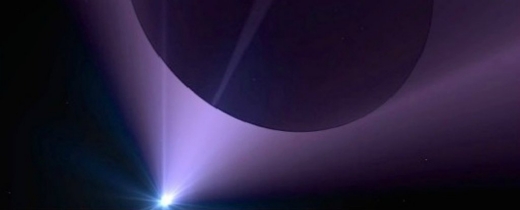
Image: An artist’s conception of a laser-beamed sail. Credit: Adrian Mann.
The April 2018 Breakthrough Committee Meeting
On April 11, the Starshot advisors met at a Breakthrough facility in the NASA Ames Space Flight Center. While C displayed the prototype holographic message plaque, I presented the case for a holographic sail. We learned that Harry Atwater of the California Institute of Technology and his team are investigating technologies that combine aspects of engineered metamaterials and holography. Most participants agreed that the idea of a holographic sail is promising. Some, including Avi Loeb of Harvard, suggested that experimental validation is required.
A number of experiments should be possible. Some of these could be addressed in response to the Starshot Sail RFP, which is scheduled for release in the near future. Jason Wentworth, a frequent contributor to Centauri Dreams, has informed me that projectiles fired by large naval guns routinely survive very high accelerations. A small thin-film hologram mounted on or in a suitable projectile might demonstrate whether a hologram can survive the requisite ~5,000 g acceleration.
It is not possible today to test a holographic filter’s reflectance and survival in a continuous ~50 GW laser beam. But according to Wikipedia, the inertial-fusion confinement lasers at the National Ignition Facility located at Lawrence Livermore can deliver 500 terawatts for a few picoseconds. Perhaps a test of a holographic sail could be performed at that facility.
If a prototype thin-film holographic spherical filter or mirror is engineered to reflect in the microwave region rather than at the laser wavelength, another test is possible using existing facilities. Beam-riding stability could be demonstrated using the equipment applied by Jim Benford, Greg Benford and colleagues to examine beam-riding stability of a number of sail shapes during 2001 [11].
In any event, the situation is hopeful. Both C and I felt that we were channeling Bob Forward during our presentation. It’s nice to imagine that his shade is smiling and cheering on the efforts of the Project Starshot team.
References
1. P. Lubin, “A Roadmap to Interstellar Flight”, JBIS, 69, 40-72 (2016).
2. Z. Manchester and A. Loeb, “Stability of a Light Sail Riding on a Laser Beam”, arXiv:submit/1680014 [astro-ph.IM] 29 Sep 2016.
3. T. Hoang, A. Lazarian, B. Burkhart, and A. Loeb, “The Interaction of Relativistic Spacecrafts with the Interstellar Medium”, arX1v: 1608.05284v1 [astro-ph.GA] a8 Aug 2016.
4. G. L. Matloff, G. Vulpetti, C Bangs and R. Haggerty, “The Interstellar Probe (ISP). Pre-Perihelion Trajectories and Application of Holography”, NASA/CR-2002-211730, NASA Marshall Space Flight Center, Huntsville, AL (June, 2002).
5. R. Haggerty and T. Stanaland, “Applications of Holographic Films in Solar Sails”, presented at STAIF-2002 Conference, University of New Mexico, Albuquerque NM (January, 2002).
6. G. L. Matloff, Deep Space Probes: To the Outer Solar System and Beyond, 2nd. ed. Springer-Praxis, Chichester, UK (2005).
7. M. Irving, “World’s Thinnest Holograms Could Lead to Thin-Film 3C displays”, New Atlas (May 18, 2017).
8. W. Wang, “Reflection and Transmission Properties of Holographic Mirrors and Holographic Fabry-Perot Filters. 1. Holographic Mirrors with Monochromatic Light”, Applied Optics, 1994, May 1;33:2560-6. doi: 10.1364/AO.33.002560.
9. P. Sharlandjiev and Ts Mateeva, “Normal incidence Holographic Mirrors by the Characteristic Matrix Method”, Journal of Optics, 16, 185-190 (1985).
10. D. W. Diehl, “Holographic Interference Filters”, Ph.D. Thesis, Institute of Optics, Schoolof Engineering and Applied Science, University of Rochester, Rochester, NY (2003).
11. James Benford, Gregory Benford, Olga Gornostaeva, Eusebio Garate, Michael Anderson, Alan Prichard, and Henry Harris, “Experimental Tests of Beam-Riding Sail Dynamics”, Proc. Space Technology and Applications International Forum (STAIF-2002), Space Exploration Technology Conf, AIP Conf. Proc. 608, ISBN 0-7354-0052-0, pg. 457, (2002).

Identifying the Sun’s Siblings
With TESS going into a 60-day period of calibration and testing, I’ll turn this morning to a different kind of survey. GALAH is an acronym for Galactic Archaeology, a term I’ve generally associated with so-called Dysonian SETI, where data is mined in a search for signs of advanced engineering or any anomalies that could signify an extraterrestrial civilization at work. But GALAH has a different object: It has examined some 340,000 stars enroute to 1 million.
A just published paper on GALAH states the goal succinctly:
The overarching goal of the GALAH survey is to acquire high-resolution spectra of a million stars for chemical tagging, in order to investigate the assembly history of the Galaxy.
The survey was launched in 2013 as a deep study of galactic formation and evolution, using the HERMES spectrograph at the Australian Astronomical Observatory’s 3.9-meter Anglo-Australian Telescope near Coonabarabran, NSW. Now coming online is a major data release, the second from GALAH, that has interesting implications not only for the broad field of galactic evolution but also the history of our own Sun. Thus Gayandhi De Silva (University of Sydney and AAO), who oversaw the work on Hermes and coordinated the effort leading to the release:
“No other survey has been able to measure as many elements for as many stars as GALAH. This data will enable such discoveries as the original star clusters of the Galaxy, including the Sun’s birth cluster and solar siblings — there is no other dataset like this ever collected anywhere else in the world.”
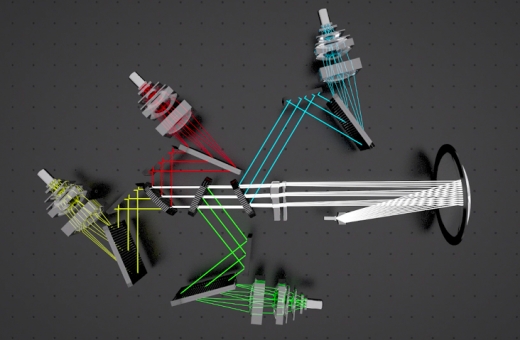
Image: A schematic of the HERMES instrument showing the path of star light from the telescope and demonstrating how it is split into four different channels. Credit: AAO.
Our recent look at the possibility of a prior civilization on our own planet is now superseded by a quest to dig much further back in time. Finding the Sun’s birth cluster leverages the fact that stars from the same originating cluster should have the same chemical composition. The problem is that clusters within the Milky Way are quickly pulled apart and are scattered. GALAH is looking to match compositional traits — the researchers call this the stars’ DNA — to parse for each star about two dozen chemical elements like oxygen, aluminium and iron.
So the day may come when we can point to stars that were born in the same cluster as the Sun. While an hour is needed to collect enough photons of light from each of the stars in the GALAH survey, the project is able to observe 360 stars at the same time, an effort that so far has involved more than 280 nights at the AAO instrument since 2014 for data collection. The HERMES spectrograph was designed by the AAO specifically for the GALAH survey.
At work here is computer code that PhD student Sven Buder, lead author of a paper on the data release, calls ‘The Cannon,’ a nod to astronomer Annie Jump Cannon, whose work on stellar spectra of several hundred thousand stars in the early 20th Century was groundbreaking. Says Buder:
“We train The Cannon to recognize patterns in the spectra of a subset of stars that we have analysed very carefully, and then use The Cannon’s machine learning algorithms to determine the amount of each element for all of the 340,000 stars.”
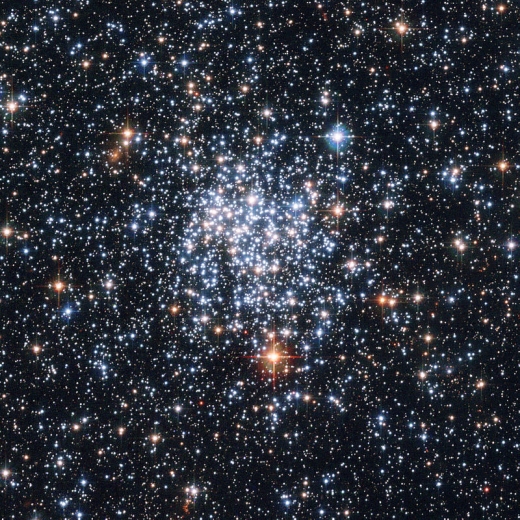
Image: Hubble has captured the most detailed image to date of the open star cluster NGC 265 in the Small Magellanic Cloud. The image taken with the Advanced Camera for Surveys onboard the NASA/ESA Hubble Space Telescope show a myriad of stars in crystal clear detail. The brilliant open star cluster, NGC 265, is located about 200,000 light-years away and is roughly 65 light-years across. Our investigations into open clusters like this may help us learn more about our Sun’s birth. Credit: ESA / NASA / E. Olszewski (University of Arizona).
Be aware that on the 25th of this month, the European Gaia satellite will likewise offer a major data release. Gaia, with its mapping of more than 1.6 billion stars in our galaxy, will mesh with the GALAH findings, using the latter’s calculations of stellar velocities to interpret Gaia data in what is becoming the most accurate atlas of the night sky ever available. From the paper:
The stellar parameter and abundance information contained in GALAH DR2 [Data Release 2] will enable major steps forward in Galactic Archaeology, including detailed work to identify clusters within the chemical space and characterize its structure and dimensionality. In combination with the dynamical information provided by Gaia DR2, we will work toward a reliable narrative of how the Milky Way was assembled and how it has evolved since, using chemodynamics and chemical tagging.
Incorporating parallax information from GAIA and broadening GALAH toward the target of one million stars is the task that lies ahead for the researchers, who plan subsequent data releases with re-analyses of all the stars from DR2 and the new stars subsequently observed.
The overview paper on GALAH, one of eleven science papers that will accompany the data release, is Buder, “The GALAH Survey: Second Data Release,” Monthly Notices of the Royal Astronomical Society Volume 476, Issue 4 (1 June 2018), pp. 5216-5232 (abstract / preprint).


